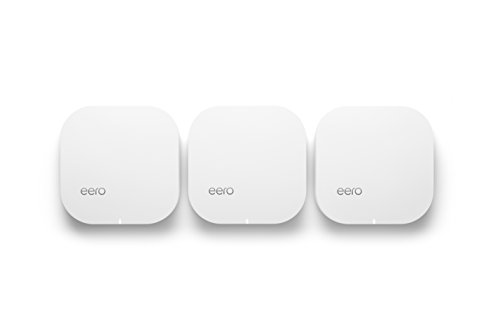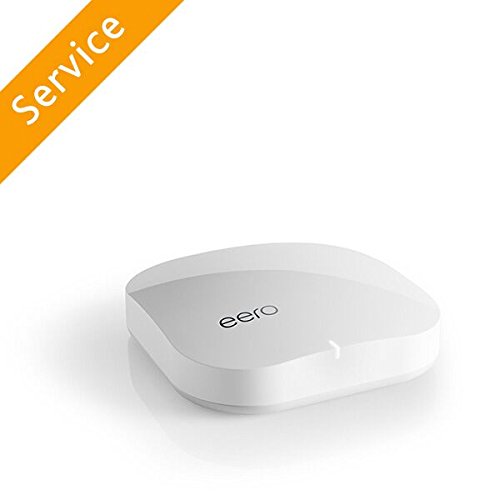In a modern home, there’s no place for bad WiFi. Whether you’re just hooking up your PC and phone or filling out an entire smart home, a top-notch router can make all the difference when it comes to keeping your home running efficiently.
Say goodbye to dead spots, buffering, and endless reboots with the eero product family. Let’s take a look at the eero vs. eero Pro vs. eero Beacon to figure out which smart WiFi setup is best for your home.
Ditch your old, unreliable router and see what a smart connection is all about. Read on below!
eero vs. eero Pro vs. eero Beacon — About
eero is a smart router line with several generations of products including the eero gen 1, eero gen 2, and eero Beacon. The second generation of eero is an upgrade in most every way, and is a continuation of the quality craftsmanship that went into their first router. Both generations of eero provide excellent connectivity throughout your home, and their range and capabilities can be further extended using the eero Beacon.
Perhaps the biggest difference between the first and second generation eero is that the newer model has a third band. This band offers an additional 5 Ghz radio which allows the router to offer more consistent and fast speeds to the various devices in your home. The second generation also has a better power adapter, using a USB-C plug rather than a barrel-style plug. Troubleshooting with the eero gen 2 is also now easier than ever before, swapping out the push-pin style hole for a small button not he back of the device. The second generation also upgraded the USB slot, moving from USB 3.0 to USB-C.
Long story short, there are some significant jumps in quality between the first eero and the new generation. With that said, all eero products work together so you can mix and match as you please. In order to set up a new eero network, you’ll need either a first or second generation device to serve as the network’s gateway. This gateway connects to your modem and creates the network, and at that point you can add in as many eeros or eero Beacons as you’d like to eliminate WiFi dead spots and fill your home with quick and reliable WiFi.
While eero no longer sells the first generation product, you can still find it on amazon. The most popular setup, however, is the eero Gen 2 with eero Beacon, but it’s also possible to buy the eero Pro Kit for three separate Gen 2 eeros.
In this comparison we’ll take a look at the eero vs. eero Pro vs. eero Beacon. All three of these setups give you excellent WiFi throughout your home, although there are pros and cons to each of them. But before we go over the various differences, let’s spend some time talking about what these three routers have in common.
eero vs. eero Pro vs. eero Beacon — Things in Common
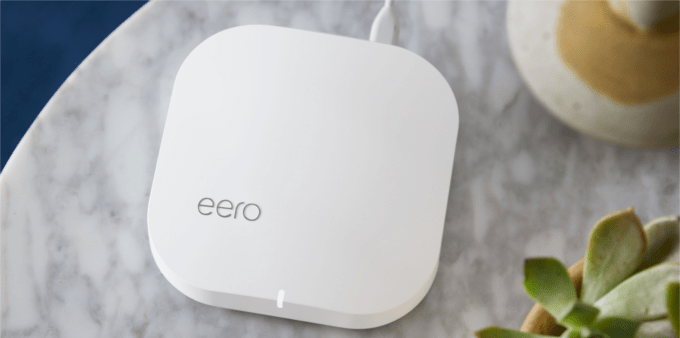
The eero, eero Pro, and eero Beacon are all part of one ecosystem, and you can use them together to improve your WiFi experience. Since they’re all variations on the same sort of router, there’s a decent amount that they have in common.
One of the biggest advantages of any of the three routers are their ability to reduce WiFi dead zones. With a traditional router, the range may be limited and not sufficient for larger homes or houses with multiple floors and complicated layouts. eero products forma a mesh network, and can extend a reliable WiFi signal far beyond the router itself.
Before you go out and outfit your home with a new eero setup, however, we recommend checking your home to see if there’s a way to address dead zones with your existing setup. Download an app like Wi-Fi Sweetspots for iOS or Wi-Fi Analyzer for Android in order to get a sense of the areas where your signal starts to drop off. In a lot of situations, you can just adjust the position of your existing router to better cover your home and save yourself the money you would have invested in a whole new system.
With that said, there are some significant advantages to an eero system even if you were to eliminate dead zones with your existing router. eero routers have some of the fastest setup in town, and you should be able to get your new network up and running in under 10 minutes. Through the eero app, you can also share your network, set up parental controls to be able to pause the internet at will, and run speed tests at your convenience.
All three of these eero setups offer intelligent WiFi that makes keeping your various devices connected and online a breeze. eero is the only product with TrueMesh technology — a feature that can intelligently route traffic between eeros and Beacons in order to avoid congestion, buffering, and drop offs. Worrying about reduced speeds and dropped connections should be a thing of the past with the reliability and convenience that the eero family has to offer.
TrueMesh works by bouncing WiFi between eeros in order to intelligently navigate your home. Oftentimes walls or long hallways can reduce the strength of signals, but with the ability to travel near-instantly between the various eero systems and Beacons, you can rest assured that your home is covered and your signal can navigate around nearly any obstacles. The majority of WiFi systems only allow for one hop in any direction, but eero allows multiple hops for the optimal connection across your entire home.
The intelligent technology built into TrueMesh can recognize the signal strength between each eero in your home, and will calculate the best path from your device to the internet — hopping quickly and efficiently to give you a speedy and stable connection. All these features combine to give you a reliable and fast connection, and it all happens in the background so you won’t have to worry about a thing.
The internet is constantly changing, and in order to keep your network running at maximum efficiency, routers will need updates from time to time. Fortunately, eero products feature automatic updates that will keep your firmware current and your network fast and adequately protected.
Speaking of protection, each of these three products are built with security in mind. eero connections are protected by Transport Layer Security (TLS) and WPA2 encryption to maintain a private and secure connection between your eero, your devices, and the cloud.
Security features include WPA2 encryption, Family Profiles, DHCP, IPV6, NAT, VPN Passthrough, UPnP, Static IP, and Port Forwarding.
Last but not least, eero supports Amazon Alexa integration. Control your WiFi using your voice with an Amazon Echo, Echo Dot, or other Alexa-enabled device. Once your Amazon device and eero are set up and on the same network, you can adjust various WiFi settings using your voice without having to open the app.
eero vs. eero Pro vs. eero Beacon — Differences
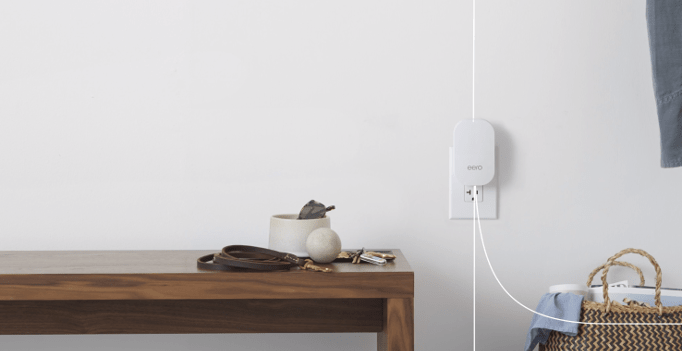
-
Difference #1: WiFi Connectivity – The primary features you’re looking for with your eero devices is a strong WiFi connection, and there are some differences in the underlying WiFi connectivity technology when comparing the devices.
The eero Gen 2 features Tri-bind WiFi radios that offer simultaneous 2.4GHz, 5.2GHz, and 5.8GHz wireless connections. So, if you decide to go with the eero Pro setup (3x Gen 2 eeros), there’ll be plenty of channels for devices to connect to — reducing congestion and improving stability and speeds overall. Backing up these radios are other useful WiFi features such as 2×2 MU-MIMO, beamforming, IEEE 802.11a/b/g/n/ac, and Threat support.
The eero Beacon, on the other hand, only has dual-band WiFi radios — allowing for simultaneous 2.4GHz, and 5GHz wireless connections. This is still probably an improvement over your average WiFi router, but it’s definitely not quite as impressive as the eero router. Just like the eero Gen 2, however, it does include 2×2 MU-MIMO, beamforming, IEEE 802.11a/b/g/n/ac and Thread support.
Long story short, the eero Gen 2 is definitely the more capable device in terms of WiFi connectivity, due to the fact that it offers three bands vs. two.
-
Difference #2: Wired Connectivity – Another advantage of the eero Gen 2 when compared to the Beacon is its support for wired connectivity. The Gen 2 hub comes with dual auto-sensing Gigabit ports for WAN and/or LAN connectivity.
The Beacon has no ports at all. Since you will need to start your WiFi network with an eero hooked into your router, that means that it’s not possible to run an eero system with an eero Beacon alone. With that said, eero Beacons are the perfect option for expanding your network as long as you’re not looking to hook many devices into the network via a hardwire.
Essentially, you’ll need at least one regular eero in order to get your network up and running. Outside of that, feel free to use any combination of eero and eero Beacon devices to fill your home with reliable WiFi.
-
Difference #3: Power – There are also some differences in the way that these routers are powered. Since the eero Gen 2 will be your main hub, it plugs into a USB-C port. This can lead to some unsightly wires, but it’s necessary due to the greater power requirements.
The eero Beacon is definitely more flexible and convenient when it comes to installation, and is designed to fit pretty much anywhere in your home. Rather than plugging in with a cord, the Beacom plugs directly into your wall. With the eero Beacon, you’ll no longer have to worry about tripping over cords and can stick your router in areas like stairwells, kitchens, and hallways.
The initial regular eero unfortunately requires the cord, but since it’s going to be hooked into your modem anyway it’s probably easy to find a spot where the cords can be easily hidden. However, if you decide to expand to eero Pro setup, then you’ll definitely end up with more wires to hide.
-
Difference #4: Nightlight – Since the eero Beacons are small, unassuming, and plug directly into outlets, they can also play double duty as a nightlight. The Beacon features a downward-shining LED nightlight which can be automatically controlled via an ambient light sensor or with a manual schedule you set in the eero app. It’s the perfect option for guiding your way down a hall at night, and gives the Beacon a little bit of extra utility beyond expanding your network to the far reaches of your home.
Whenever you want to turn off the LED light on your eero, simply open up the eero app or give a simple voice command using the eero Amazon Alexa skillset.
-
Difference #5: Size – There are some significant differences in the size of the eero models, but there are also some shrinking similarities. When you take a look at both the eero Gen 2 and the eero Beacon, it’s pretty easy to see that the Beacon is essentially an eero cut in half. The 4.76 x 2.91 x 1.18 in Beacon is designed to fit in seamlessly with your existing plugs, and is roughly 50% of the thickness of the 4.75 x 4.75 x 1.24 eero Gen 2.
If you’re looking for the most inconspicuous setup, it probably makes sense to buy a single eero Gen 2 and then fill out the rest of your home with eero Beacons.
-
Difference #6: Placement – One aspect to keep in mind when installing your eero system is that placement really matters. In order to get the best WiFi signal over your entire home, it’s important that you install your eeros in the right places and keep them oriented correctly.
The eero Gen 2 requires that it be placed in the open on a hard, flat surface. This means that you can’t hide it in a cabinet, drawer, or closet if you want the optimal connections. From there you can place other eero Gen 2 models to create the eero Pro setup, on any flat surface throughout your home, with desks, tables, shelves, and counters all fair game.
The Beacons are even more flexible when it comes to placement, as all you really need is an available outlet. The router is roughly the width of your average power outlet, and there’s no need to worry about finding a surface for it to sit on or dealing with a cord. It may be worthwhile to consider areas that you want lit up at night too, since you might as well take advantage of the night light feature!
-
Difference #7: Use Case – Last but not least, there’s a difference in the use case between the eero Gen 2 and the eero Beacon.
Since the eero Gen 2 or a regular eero is required for all home networks due to its ability to hook into your modem, its main use case is to serve as a gateway and for heavily wired homes.
The eero Beacon, on the other hand, serves exclusively as an add-on on an existing eero router.
The type of combination between eero routers and eero Beacons that is best for your home is really going to depend on the size of your house.
For small homes and apartments, we recommend an eero and eero Beacon pack. Having one of each should be more than sufficient to cover the entirety of your property, as the company recommends 1-2 eeros per floor.
For the majority of homes that are a little bit larger, you might be better off with the eero and two Beacons pack. That extra Beacon will really help extend your WiFi signal to the far reaches of your home, and is ideal for houses that have two or more floors.
Large homes, meaning those with more than three floors, may benefit from purchasing an eero Pro kit. Feel free to mix and match eero routers and eero Beacons in order to find the setup that works best for you.
There are very few cases in which you’d need more than one eero router and two Beacons in a residential setting, so that package is probably your best bet unless you have a very large home or a large number of floors, in which case the eero Pro setup is a better option.
No products found.
eero vs. eero Pro vs. eero Beacon — Comparison Chart
| eero Gen 1 | eero Gen 2 | eero Beacon | |
|---|---|---|---|
| WiFi connectivity | Dual-band 2.4/5.2 Ghz IEEE 802.11a/b/g/n/ac |
Tri-band 2.4/5.2/5.8 Ghz IEEE 802.11a/b/g/n/ac |
Dual-band 2.4/5.2 Ghz IEEE 802.11a/b/g/n/ac |
| 2×2 MU-MIMO | Yes | Yes | Yes |
| Wired connectivity | Two 1Gb ports for WAN and/or LAN connectivity | Two 1Gb ports for WAN and/or LAN connectivity | None |
| Smart home connectivity | Thread 1.1 Border Router, Bluetooth® LE 4.2 | Thread 1.1 Border Router, Bluetooth® LE 4.2 | Thread 1.1 Border Router, Bluetooth® LE 4.2 |
| Power Adapter | Barrel-style plug | Uses a USB-C | Plugs into outlet |
| Nightlight | None | None | 10 Lumen LED nightlight, with automated dimming |
| Electrical requirements | 100-240V AC, 50-60 Hz | 100-240V AC, 50-60 Hz | 100-240V AC, 50-60 Hz |
| Processor | 1.0GHz dual-core | 700 MHz quad-core | 700 MHz quad-core |
| Memory | 512MB RAM | 512MB RAM | 512MB RAM |
| Storage | 4GB flash storage | 4GB flash storage | 4GB flash storage |
| Security and network services | WPA2 encryption, Family Profiles, DHCP, IPV6, NAT, VPN Passthrough, UPnP, Static IP, and Port Forwarding | WPA2 encryption, Family Profiles, DHCP, IPV6, NAT, VPN Passthrough, UPnP, Static IP, and Port Forwarding | WPA2 encryption, Family Profiles, DHCP, IPV6, NAT, VPN Passthrough, UPnP, Static IP, and Port Forwarding |
| Dimensions | 4.76in (121mm) x 4.76in (121mm) x 1.26in (32mm) | 4.76in (121mm) x 4.76in (121mm) x 1.26in (32mm) | 4.76in (121mm) x 2.91in (74mm) x 1.18in (30mm) |
| Add-on Service | eero Plus | eero Plus | eero Plus |
| Range | 1 eero + 1 eero Beacon Covers 1-2 bedrooms or up to 2,000 sq. ft. 1 eero + 2 eero Beacons Covers 2-4 bedrooms or up to 3,000 sq. ft. |
1 eero + 1 eero Beacon Covers 1-2 bedrooms or up to 2,000 sq. ft. 1 eero + 2 eero Beacons Covers 2-4 bedrooms or up to 3,000 sq. ft. |
1 eero + 1 eero Beacon Covers 1-2 bedrooms or up to 2,000 sq. ft. 1 eero + 2 eero Beacons Covers 2-4 bedrooms or up to 3,000 sq. ft. |
| Color | White | White | White |
eero vs. eero Pro vs. eero Beacon — Accessories
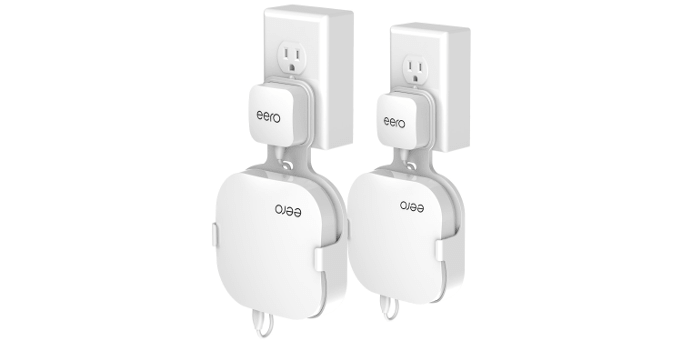
While the eero routers will function well on their own, there are some optional accessories that may be worth looking into if you want to expand the functionality of your WiFi.
The most notable accessory for all eero products is probably the subscription service: eero Plus.
eero Plus is primarily a security-focused subscription plan that extends and enhances the capabilities of your router setup. A regular threat scan will check the sites you visit against a database of millions of known threats to ensure that you don’t end up navigating to items that pose a threat to your network. Family safe browsing will also automatically tag sites that contain violent, illegal, or other adult content so you have complete control over the type of sites your children can visit.
Ad-blocking across all of your devices allows you to get rid of annoying ads and pop-ups while browsing the web, and increases load times for ad-heavy sites so you don’t have to deal with a slow browsing session.
In addition to these security features, an eero Plus subscription includes access to security apps like VPN protection through encrypt.me for increased privacy and security, and easy password management through 1Password.
For the price of $99/yr, you get all of the above as well as access to Malwarebytes — one of the most sophisticated antivirus softwares. All of these features purchased separately would amount to hundreds of dollars a year, so the eero Plus subscription is definitely worth the investment for those who are concerned about their network’s security.
Also, while eero systems are generally pretty easy to get installed on your own, there’s also the option to have a professional take the hassle out of your hands with the eero WiFi system setup from Amazon.
For the eero routers there are also a number of different mounting options to consider that will take your router off the table while keeping it functioning optimally. We recommend taking a look at the MYRIANN Wall Mount Holder for eero, the Wall Outlet Mount Holder, and the HumanCentric Wall, Ceiling and Drop Ceiling Mount Bracket.
eero vs. eero Pro vs. eero Beacon — Our Thoughts

When shopping for eero routers, there are a variety of setup options. But which is best?
Honestly, there are a lot of different ways you could go to get an excellent smart WiFi setup. Our top recommendation is the eero Pro pack if you have the option of hard wiring eeros, as you’ll get better performance due to the support for tri-band WiFi radios. Plus you’ll be able to plug in your wired smart home devices to the eero routers, ensuring a super-fast Internet connection.
Other than that, the Gen 2 eero and a few Beacons is also an excellent option, and the night light is a cool added perk.
No products found.
eero products are designed to work seamlessly with one another, so it’s pretty hard to go wrong. As long as you don’t buy a single eero Beacon with no regular router to go with it, it’s pretty hard to go wrong. Just keep an eye on the needs of your home and expand your system as needed to ensure you don’t end up with any pesky dead spots.
Last update on 2024-04-15 at 23:59 / Affiliate links / Images from Amazon Product Advertising API


